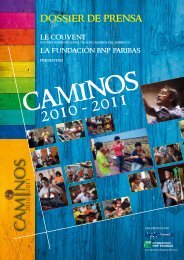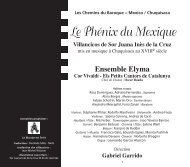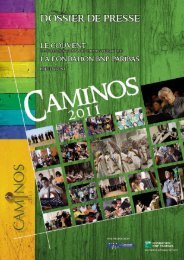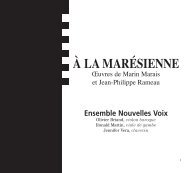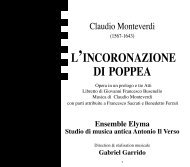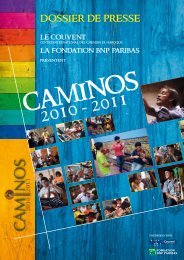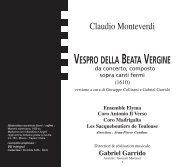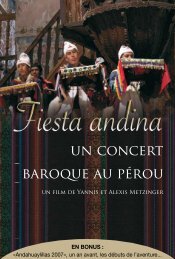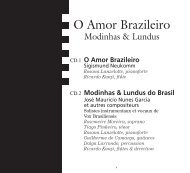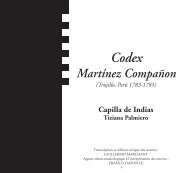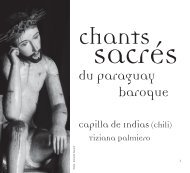Musique et poésie des Juifs en Italie à la Renaissance Music and ...
Musique et poésie des Juifs en Italie à la Renaissance Music and ...
Musique et poésie des Juifs en Italie à la Renaissance Music and ...
- No tags were found...
Create successful ePaper yourself
Turn your PDF publications into a flip-book with our unique Google optimized e-Paper software.
de rénover le répertoire, ne voulur<strong>en</strong>t pas oublier toutà fait <strong>la</strong> gr<strong>and</strong>e histoire de c<strong>et</strong>te musique composite. Ilest facile de s’<strong>en</strong> r<strong>en</strong>dre compte <strong>en</strong> écoutant <strong>des</strong> chantsqui, sous une appar<strong>en</strong>ce «moderne», gard<strong>en</strong>t <strong>des</strong> échostrès marqués <strong>des</strong> musiques du XVIII e ou du XVII e siècle<strong>et</strong> même plus anci<strong>en</strong>nes. En fait, si nous écoutons leschants de Shabbat <strong>et</strong> de toutes les fêtes juives quirésonn<strong>en</strong>t aujourd’hui dans les synagogues itali<strong>en</strong>nes,ou qui résonnai<strong>en</strong>t il y a quelques déc<strong>en</strong>nies, avant que<strong>la</strong> t<strong>en</strong>tative de suppression de l’hébraïsme <strong>en</strong> Europeréalisée par le nazisme <strong>et</strong> le fascisme m<strong>et</strong>te à dureépreuve aussi <strong>la</strong> survie <strong>des</strong> communautés itali<strong>en</strong>nes,surtout celles <strong>des</strong> c<strong>en</strong>tres mineurs. Si nous écoutonsces chants qui, par miracle, sont <strong>en</strong>core vifs <strong>et</strong> trèssouv<strong>en</strong>t exécutés <strong>et</strong> non pas comme pour beaucoupd’autres traditions anci<strong>en</strong>nes, l’apanage exclusif <strong>des</strong>chercheurs, c’est comme si nous écoutions un conc<strong>en</strong>tréde l’histoire de <strong>la</strong> musique <strong>des</strong> <strong>Juifs</strong> d’<strong>Italie</strong> <strong>et</strong> <strong>des</strong>Itali<strong>en</strong>s. La mémoire de <strong>la</strong> musique que, p<strong>en</strong>dant <strong>la</strong>R<strong>en</strong>aissance, les <strong>Juifs</strong> échangeai<strong>en</strong>t avec les Itali<strong>en</strong>s est<strong>en</strong>core très prés<strong>en</strong>te. C<strong>et</strong> échange, c<strong>et</strong> <strong>en</strong>chevêtrem<strong>en</strong>t,c’est ce que notre travail essaye de raconter.Enrico Fink(traduction Luc<strong>et</strong>te Barattini Biggi)the Jews in Italy is above all a history of interaction,<strong>and</strong> its primary interaction has always be<strong>en</strong> with thesurrounding world: decade after decade, c<strong>en</strong>tury afterc<strong>en</strong>tury with the contemporary tr<strong>en</strong>ds of Italian music– the belcanto style used in the nin<strong>et</strong>e<strong>en</strong>th c<strong>en</strong>turyis just one of many examples. The same nin<strong>et</strong>e<strong>en</strong>thc<strong>en</strong>turycomposers who were called upon to modernize<strong>and</strong> aggr<strong>and</strong>ize had no <strong>des</strong>ire to compl<strong>et</strong>ely forg<strong>et</strong>the <strong>en</strong>tire history of this composite music: there are somany instances of this, with ‘modern’ tunes carryingstrong echoes of melodies from the eighte<strong>en</strong>th c<strong>en</strong>tury,the sev<strong>en</strong>te<strong>en</strong>th c<strong>en</strong>tury, <strong>and</strong>, som<strong>et</strong>imes, earlier still.If we list<strong>en</strong> to the melodies that fill the synagogues ofItaly every Shabbes <strong>and</strong> Jewish Holiday – although, insome cases, filled would perhaps be a more accurat<strong>et</strong>erm, referring to the situation before the Nazi-Fascist attempt to erase Italian <strong>and</strong> European Jewrymade it very difficult for the communities themselves,especially in the smaller towns, to survive; if we list<strong>en</strong>to this repertoire that is miraculously still vibrant, <strong>and</strong>regu<strong>la</strong>rly sung, unlike so many other old traditionswhich have become limited to material for study byacademics <strong>and</strong> researchers; If we list<strong>en</strong> to the melodiesthat fill the synagogues of Italy every Shabbes <strong>and</strong>Jewish Holiday – although ‘filled’ would, in somecases, perhaps be a more accurate term, referring tothe situation before the nazi-fascist attempt to eraseItalian <strong>and</strong> European Jewry made it very difficult forthe communities themselves, especially in the smallertowns, to survive - if we list<strong>en</strong> to this repertoire that ismiraculously still vibrant, <strong>and</strong> regu<strong>la</strong>rly sung, unlike somany other old traditions, that have become limited tomaterial for study by academics <strong>and</strong> researchers; if welist<strong>en</strong> closely, it is like list<strong>en</strong>ing to a cond<strong>en</strong>sed historyof Italian Jews <strong>and</strong> of Italians in g<strong>en</strong>eral. The memoryof the music that the Jews in R<strong>en</strong>aissance Italy sharedwith their Italian neighbors is still there. This exchange,this interdep<strong>en</strong>d<strong>en</strong>ce, is the ‘Istoria’ that this programtries to tell.Enrico Fink6



